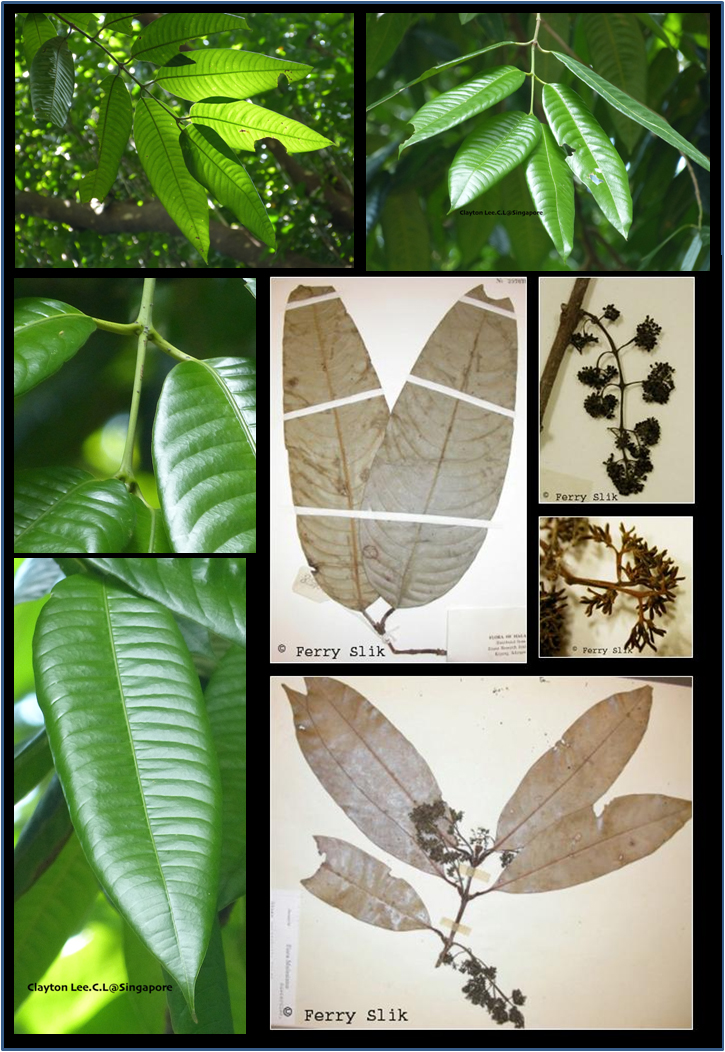Bouea macrophylla Griff., Pl. Cantor in J. As. Soc. Beng. 23 (1854)
(Latin for 'Large leaves')Synonyms
Bouea gandaria Bl.
Tropidopetalum javanicum Turcz.
Diagnostics
Tree with clear sap turning black. Stipules absent. Leaves opposite which is rare
within the Anacardiaceae, distichous (in one plane along the twig), simple, large, glabrous. Flowers
small, placed in small branched inflorescences. Fruits c. 3 cm long, orange-red fleshy drupes.
Description
Tree up to 27 m high and 55 cm diameter. Bark light greyish brown, or dark coloured, finely fissured.
Terminal (vegetative) buds broadly ovoid or ovoid, 4-6 by 3.5-5 mm, scales of outer pair usually
shorter than the total length of bud. Leaves coriaceous, ovate-oblong to lanceolate, or elliptic
to narrowly elliptic, (11.5-)14.5-30 by (4-)5-8 cm (on sterile specimens up to 45 by 13 cm), glabrous;
base acute to cuneate, rarely obtuse; apex acute to acuminate; nerves 15-25 pairs, veins reticulate,
sometimes faint; petiole l-2.5 cm. Panicles 4.5-10(-12.5) cm long; pedicels 0-2 mm. Flowers
light yellowish green or light yellow, soon becoming brown. Calyx lobes broadly ovate, c. 0.7 mm
long. Petals oblong, or oblong-obovate, 1.5-2.5 by c. 1 mm. Stamens 0.6-1 mm; anthers apiculate.
Disk small, thin, c. 0.7 mm diameter. Ovary c. 0.5 mm diameter. Drupe subglobose,
3.5-5 by 3-4 cm, yellow or orange when ripe; cotyledons blue-violet. [from Flora Malesiana]
Ecology
Gandaria is a tree of the humid tropics and thrives in light and fertile soil. It occurs naturally
in lowland forests below 300 m altitude, but has been successfully cultivated up to elevations of
about 850 m.
Uses
A popular fruit tree with diminutive mango-like fruits. Although generally rather acid even when fully
ripe, the fruit is much consumed fresh, cooked in syrup or made into an excellent compote. However,
the use of the young fruits is more important; they serve as ingredient of a special kind of 'sambal',
the chilli-based condiment, and in pickles ('asinan'), the bright purple cotyledons in the big seed
adding to the attraction of the concoction. Occasionally the young leaves ¡ª which are deep violet,
sometimes strikingly white when they emerge ¡ª are also consumed fresh, to be eaten with the gandaria-
flavoured 'sambal'. Gandaria is recommended for planting in transmigration areas in Sumatra because of
its abundant fruit production and very dense foliage, making it an excellent shade tree. The timber is
durable but only used for minor purposes.
Distribution
Native to north Sumatra, Peninsular Malaysia and west Java, and is cultivated widely as a fruit tree
in Sumatra, the wetter parts of Java, Borneo and Ambon, as well as Thailand (where it is locally
important).
Local names
Java: gandaria, djantake, gunarjah, kendarah, djatake, pao gandaria.
Malay Peninsula: asam suku, kondongan, kundang(an), kundang hutan, medang asam, pako kundangan,
rembunia, remenya, rumenia, rumia, serapoh, serapok, setar.
Sumatra: ramania (Langkat).
Thailand; Malay Peninsula, Sumatra, West Java and Borneo.
